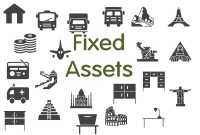- Home
- Business Processes
- Industry Knowledge
- Aerospace Industry
- Automotive Industry
- Banking Domain
- BFSI Industry
- Consumer/ FMCG Industry
- Chemicals Industry
- Engineering & Construction
- Energy Industry
- Education Domain
- Finance Domain
- Hospitality Domain
- Healthcare Industry
- Insurance Domain
- Retail Industry
- Travel and Tourism Domain
- Telecom Industry
- Leadership Skills
- eLearning
- Home
- Functional
- Asset Management
- Fixed Asset Barcoding
Fixed Asset Barcoding
Physical assets are frequently out in the field for use; undergo repairs, sold, updated, removed or stolen. From purchase to disposal and all of the steps in between, an asset’s history can be easily traced and reviewed using an asset management system that utilizes asset tags or asset labels.
Once the asset is procured/ placed in service, the organization affixes asset tags with descriptive information such as asset number, expenditure code, asset description, cost center, and a bar code.
Bar Code Label Considerations
If you are thinking of using Bar Code labels to assist with your stock takes, there are some aspects to consider beforehand. You need to decide what style of bar code you will use. The style “Code3of 9” is popular and readable by most scanning devices. You will also need to consider the type of label media that best suits your company’s operations.
Type of Label Paper
Label paper ranges from tough metallic formats that are difficult to remove from assets to cheaper “Indestructible Vinyl” that is reasonably durable.
Type of Label Media
- Tough Metallic Formats
- Cheaper Indestructible Vinyl
Scanning Devices
You should decide how many scanning devices you will require if your operations are spread out between cities or states, or you may decide to send a single device around to various regions when it is their turn to perform an asset stock take.
Number of Scanning Devices
- Single Device sent from HO
- Multiple Devices at Prime Locations
Printing of Labels
You then need to consider the printing of the labels. There are many companies that will pre-print your labels with asset numbers for you. Alternatively, you may decide to purchase your own bar code printer and design a custom report in your FA system to print a range of numbers. A bar code is printed by sending a series of escape characters to a special printer, which decodes the escape characters and converts them to bar codes. It is easy to include your company name and the actual asset number on the label for further identification. The appropriate escape characters are usually listed and explained in the printer manuals. The following picture shows a reasonably simple, but effective bar code.
Style of Bar Code
- Code 3of9 is readable by most devices
- ERP Tailored
Printing of Labels
- Buy Preprint Labels
- Use Barcode Printer with Custom Software
Evaluation Factors:
- Tag Suitability
- Support Network
- Standards Compliance
- Solution Availability
- Solution Flexibility
- Solution Compatibility Solution Integration
- Solution Scalability
- Solution Cost
- Vendor Partnership
Related Links
You May Also Like
-
Introduction to Capital Asset Planning
Before you purchase an asset in any organization, you must justify the decision to purchase the asset and get requisite approvals to make investment and release the funds. These series of analysis steps where cost-benefit analysis is performed to justify the decision to purchase a prospective asset is called the process of capital asset planning or simply as capital budgeting.
-
Physical assets are frequently out in the field for use; undergo repairs, sold, updated, removed or stolen. From purchase to disposal and all of the steps in between, an asset’s history can be easily traced and reviewed using an asset management system that utilizes asset tags or asset labels.
-
Fixed Assets - Key Terminology
In this article, we have explained the meaning and usage of key generic terms that are used in almost every FA management system/ Fixed Assets process. Understanding these terms is a prerequisite to building a solid understanding of the fixed assets business process.
-
Costs subsequent to acquisition of fixed assets
Costs related to plant assets that are incurred after the asset is placed in use are either added to the fixed asset account (capitalized) or charged against operations (expensed) when incurred. In this article, we will discuss underlying principles for this accounting event.
-
Asset Maintenance – Tagging & Physical Verification
Most organizations need to deal with hundreds or even thousands of physical assets. In such a case, it’s important to know the operating condition and location of the assets owned by them at periodical intervals. Identifying, tracking, and controlling assets are a critical step in ‘Asset Maintenance’.
-
An asset is anything that will probably bring future economic benefit. Every company must take actions to safeguard, control, and manage the assets it owns. Cash Assets needs to be managed effectively to safeguard and utilize them efficiently. In this section, we will start with understanding what are assets, what are various classification of assets and then we will focus on Asset Management.
-
A fixed asset register (FAR) is accounting book with a list of fixed assets belonging to particular entity. Traditionally the fixed asset register was maintained in written form by the accountant using a book that was set aside specifically for tracking fixed assets. Now with the advent of IT systems for bookkeeping it is more often held in electronic format. Learn the importance of maintaining a FAR.
-
“Fixed Assets” is a six-step process and starts with initiating and approving the request to acquire the asset and after maintaining and depreciating for useful life ends with the final disposal of the fixed asset. These steps are cyclic in nature and most of them happen in any fixed management lifecycle. Some optional steps may happen only in certain business scenarios or in specific industries.
-
Key challenges in managing FA process
As organizations grow in scale they need a more detailed justification of capital expenditure. This leads to many functions getting involved in the fixed asset management process with significant “hand-offs” at each step/stage. In this chapter, we will address a broad array of issues involved in the process of fixed assets in any large scale organization.
Explore Our Free Training Articles or
Sign Up to Start With Our eLearning Courses

About Us
Learning
© 2023 TechnoFunc, All Rights Reserved









